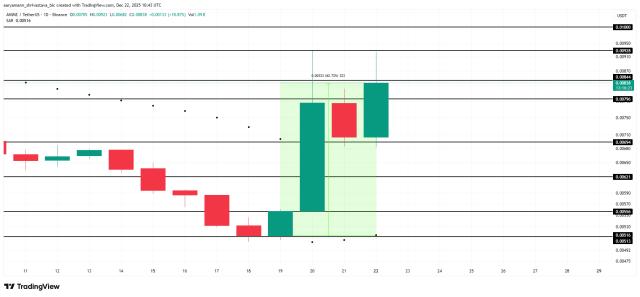Just two days later, the RWA project Backed announced on March 8 that it had launched the Coinbase stock derivative token wbCOIN on the Base network, with the token value supported 1:1 by COIN stock. Although Backed claimed to clarify that this move was unrelated to Coinbase, the speed of the action makes it difficult not to speculate.
Over the weekend, crypto analyst Tiao.sol posted on X, analyzing the multiple arbitrage opportunities that may exist between the two markets under the "parallel coin and stock" model, which may provide you with some new trading inspirations in the face of the current market uncertainty.
The following is the original content, compiled by Odaily.
With Backed launching a tokenized version of Coinbase stock (wbCOIN) on the Base blockchain, the SEC's regulation seems to have fully opened the door. This may mark a transformative change in the financial markets, hinting that other U.S. stocks may soon begin to be tokenized. For traders, this not only brings new market opportunities, but also introduces unique trading strategies.
In the following, I list several potential arbitrage opportunities and strategies, welcome everyone to supplement and discuss.
Opportunity One: Price Arbitrage
Scenario
The traditional U.S. stock market may experience violent fluctuations due to news, macroeconomic data or corporate events (such as earnings releases), while the on-chain tokenized stocks (such as wbCOIN) may not be able to immediately reflect these changes due to lack of liquidity or price data delays.
Strategy
Monitor the price spread between the traditional market (such as Coinbase stock COIN) and its tokenized asset (such as wbCOIN). If COIN drops (or rises) significantly in the traditional market, while wbCOIN reacts sluggishly in the crypto market, traders can buy (or sell) COIN at a lower (or higher) price in the traditional market, while selling (or buying) wbCOIN at a higher (or lower) price in the crypto market.
Risks
Price data delays, high transaction fees, blockchain network congestion, and legal risks between the token and the actual stock value (such as the token failing to effectively anchor the stock).
Example
If COIN drops to $200 in the traditional market, but due to liquidity issues wbCOIN still maintains at $205, the trader can buy COIN in the traditional market and sell wbCOIN in the crypto market, locking in a $5 profit (after deducting fees and slippage).
Opportunity Two: Liquidity Spread Arbitrage
Scenario
The liquidity of tokenized stocks in the crypto market is usually lower than the traditional U.S. stock market, especially when trading volume is low, the bid-ask spread is often quite large.
Strategy
Buy the stock (such as COIN) at near-market prices in the traditional market, convert it to a token (such as wbCOIN) through the blockchain mechanism (such as Base or other DeFi platforms), and then sell it at a premium in the crypto market. Alternatively, earn profits from the bid-ask spread by providing liquidity (market making) in the low-liquidity market.
Risks
The low liquidity may limit trading volume and make it difficult to exit quickly; the on-chain gas fees may also erode profits.
Example
If the buy price of wbCOIN is $205 and the sell price is $210 on AerodromeFi or CoWSwap platform, the trader can provide liquidity by placing buy and sell orders to earn the $5 spread.
Opportunity Three: 24*7 Time Arbitrage (Time Zone Arbitrage)
Scenario
The traditional U.S. stock market is only open from 9:30 a.m. to 4:00 p.m. Eastern Time on weekdays, while the on-chain tokenized stocks trade 24*7 around the clock. This provides an opportunity to leverage global market fluctuations during the U.S. market closure.
Strategy
After the U.S. market closes, the global market (such as Asia or Europe) may affect the price of Coinbase or other U.S. stocks due to news or events, while wbCOIN in the crypto market may not have fully adjusted. Traders can buy (or sell) wbCOIN at a lower (or higher) price in the crypto market and wait for the price to correct when the U.S. market reopens.
Risks
Violent price fluctuations may lead to losses; token prices may deviate from true value due to low participation.
Example
After the U.S. market closed on Friday, an event in Asia boosted the outlook for Coinbase, but wbCOIN had not yet risen. Traders can buy wbCOIN at a low price in the crypto market and sell it when the U.S. market reopens on Monday.
Opportunity Four: Cross-Market Arbitrage
Scenario
Tokenized stocks are often traded on multiple chains (such as Base, Ethereum, Polygon), multiple traditional trading platforms (such as NYSE, Nasdaq) and multiple DeFi protocols (such as Uniswap), and there may be price differences between different platforms.
Strategy
Monitor the prices of wbCOIN or other tokenized stocks on different platforms. If the price on Base is lower than the price on Ethereum or the traditional market, traders can use cross-chain bridges or traditional market entry and exit channels to buy at a lower price on one platform and sell at a higher price on another.
Risks
Cross-chain transaction delays, relatively high gas fees, regulatory differences between platforms.
Example
If the price of wbCOIN is $200 on Base but $205 on Ethereum, the trader can buy on Base and sell on Ethereum, earning the spread (after deducting cross-chain fees).
Opportunity Five: Event-Driven Arbitrage
Scenario
Major events (such as Coinbase earnings, regulatory news or hacking attacks) may lead to asynchronous price movements between traditional stocks and their tokenized versions.
Strategy
Predict events that may impact Coinbase or other U.S. stocks (such as changes in SEC policies, mergers, acquisitions, etc.), predict price movements, and trade on the price differences between traditional stocks and their tokenized versions after the event.
Risks
The outcome of the event is highly uncertain; prices may further deviate from expectations.
Example
If Coinbase releases a positive earnings report, COIN rises 10% in the traditional market, while wbCOIN only rises 5% due to low liquidity, the trader can buy wbCOIN at a low price in the crypto market and wait for the price to correct.
Key Factors
· Sufficient liquidity: The current liquidity of tokenized stocks is still relatively low, which to some extent limits the scale of arbitrage.
· Fees and slippage: On-chain gas fees, traditional market commissions, and transaction fees in token trading may erode profits.
Summary and Recommendations
With the launch of wbCOIN, the tokenized versions of other U.S. stocks (especially stocks with high liquidity and high visibility like Apple, Amazon, Tesla) are also expected to gradually go on-chain.
In summary, the price, liquidity and time differences between tokenized stocks and traditional stocks, as well as cross-market and event-driven fluctuations, provide traders with multiple potential arbitrage opportunities.
In terms of tools, I recommend using real-time market data tools (such as TradingView, CoinGecko) and blockchain analysis platforms (such as dune analytics) to track prices and liquidity. Also set strict stop-loss and take-profit levels, monitor gas fees and slippage to ensure profits can cover costs.
Welcome to join the official BlockBeats community:
Telegram subscription group: https://t.me/theblockbeats
Telegram discussion group: https://t.me/BlockBeats_App
Twitter official account: https://twitter.com/BlockBeatsAsia







